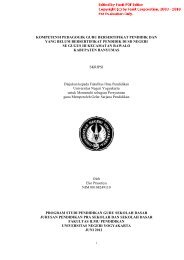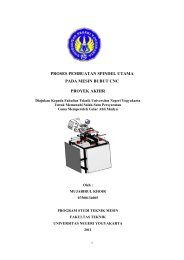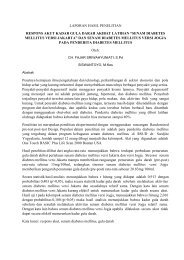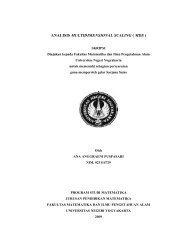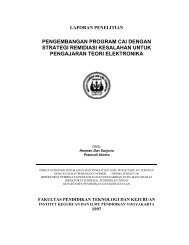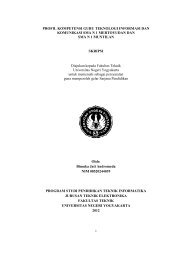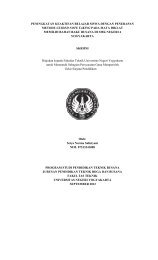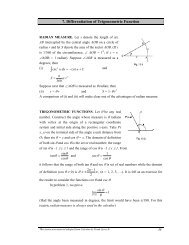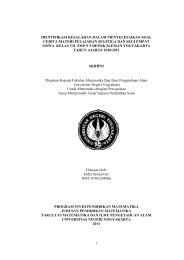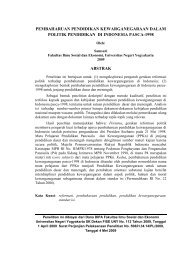aboriginal land rights issueas recorded in oodgeroo noonuccal's ...
aboriginal land rights issueas recorded in oodgeroo noonuccal's ...
aboriginal land rights issueas recorded in oodgeroo noonuccal's ...
Create successful ePaper yourself
Turn your PDF publications into a flip-book with our unique Google optimized e-Paper software.
--- -- --ABORIGINAL LAND RIGHTS ISSUEAS RECORDED INOODGEROO NOONUCCAL'S "WE ARE GOING"by Sugi IswalonoFaculty of Arts and LanguagesState University ofYogyakartaAbstrakCara pandang bangsa kulit hitam Australia, yaitu bangsaAborij<strong>in</strong>, dan bangsa kulit putih Australia terhadap tanah tempatt<strong>in</strong>ggal mereka sangat berbeda. Bagi bangsa Aborij<strong>in</strong> tanah tempatt<strong>in</strong>ggal mereka mempunyai nilai yang sangat t<strong>in</strong>ggi, terutama nilairelijius, sementara, bagi bangsa kulit putih tanah yang sarna hanyadipandang sebagai asset ekonomi yang dapat diperjual-belikankapan saja mereka mau. Karena perbedaan persepsi yang sangattajam <strong>in</strong>i, tidaklah mengherankan apabila bangsa kulit hitam <strong>in</strong>ikemudian mengalami penderitaan psikologis yang sangat panjangsejak 'tanah suci' mereka diambil alih oleh bangsa kulit putihAustralia demi kepent<strong>in</strong>gan ekonomi semata. Namun demikian,dewasa <strong>in</strong>i rupa-rupanya bangsa Aborij<strong>in</strong>telah mulai menunjukkanprotes kerns mereka terhadap penggusuran tanah yang merekaalami selama <strong>in</strong>i. Mereka tidak hanya melakukan manuvermanuverpolitik untuk menunjukkan protes mereka terhadapbangsa kulit putih Australia, tetapi juga memanfaatkan sastrasebagai media untuk mengekspresikan protes mereka. Di antarapara sastrawan dari kelompok <strong>in</strong>i adalah Oodgeroo Noonuccal,yang sebelumnya menggunakan nama Barat Kath Walker.Oodgeroo <strong>in</strong>ilah yang mempelopori penggunaan puisi sebagaisarana untuk mengekepresikan protes mereka terhadappenyerobotan tanah yang telah mereka warisi dari nenek moyangmereka oleh bangsa kulit putih Australia. Dengan demikian, diamerupakan orang Aborij<strong>in</strong> pertama yang menerbitkan kumpulanpuisi kontemporer Australia. Kumpulan karya dia <strong>in</strong>i diberi judul"We Are Go<strong>in</strong>g". Karya <strong>in</strong>i jelas menunjukkan bahwa antarakehidupan bangsa Aborij<strong>in</strong> dengan karya yang mereka hasilkanterdapat hubungan yang sangat erat, apalagi fakta juga telahmenunjukkan bahwa para penulis kulit hitam Australia yang la<strong>in</strong>158
159telah pula merekan kepedihan dan keterp<strong>in</strong>ggiran mereka dalamkarya sastra yangmnerekahasilkan.Kata Kunci: Aborig<strong>in</strong>, Oodgeroo Noonuccal.WeAre Go<strong>in</strong>gA. IntroductionRecently the Aborig<strong>in</strong>al Land Rights issue seems to have beenpolitically prom<strong>in</strong>ent <strong>in</strong> Australia. Aborig<strong>in</strong>al activists have alwaysprotested over the dispossessionof their <strong>land</strong> by white people and foughtto rega<strong>in</strong> their <strong>land</strong>. When Australia organized the WorldExpo <strong>in</strong> 1988<strong>in</strong>Brisbane, Aborig<strong>in</strong>al people brought about a demonstration <strong>in</strong> MusgravePark, which is near the expo location. It was a clever undertak<strong>in</strong>g as theworld would give their attention to them. They also make use of art as ameans of manifest<strong>in</strong>g their struggle for their <strong>land</strong> <strong>rights</strong>. In 1988 <strong>in</strong>Sidney, for example, they performed a drama called The Struggle ofNaga Tribe. It is about the Naga tribe's struggle to protect their <strong>land</strong>sfrom the government which wants to sell them because they have richm<strong>in</strong>erals. It was orig<strong>in</strong>ally written by one of the most outstand<strong>in</strong>gIndonesian playw<strong>rights</strong>, W. S. Rendra, which was then translated <strong>in</strong>toEnglish by Max Lane. In fact, they adapted the story to meet Aborig<strong>in</strong>alconditions.This paper explores how the <strong>land</strong>s are traditionally andeconomically essential to Aborig<strong>in</strong>es. It also po<strong>in</strong>ts out that Aborig<strong>in</strong>alpeople and the white people aredifferent<strong>in</strong> their perception of<strong>land</strong>.B. Aborig<strong>in</strong>al LiteratureAborig<strong>in</strong>al literature is seen to bear peculiarity. A reflection ofthe oppressed and marg<strong>in</strong>alized life-experiences of these <strong>in</strong>digenouspeople can be explored <strong>in</strong> their literary production. Moore (1971: 4)highlights such a relationship by stat<strong>in</strong>g that literature "is ultimatelyautobiographical, spun with thread drawn, like a spider's web, from theAborig<strong>in</strong>al Land Rights Issue (Sugi Iswalono)- ---
- - - -160body of the writer's perception and thoughts, dreams and desires andmemories". Johnston, as quoted by Colmer (1989: 32), endorses thisnotion by stat<strong>in</strong>g that "any serious work of fiction ... must beautobiographical <strong>in</strong> a lesser or greater degree, s<strong>in</strong>ce the author's mostreliable touchstone and yardstick to experience and emotion mustalways be himself'. This unique position of literature is furthermoreargued by Spender (<strong>in</strong> Colmer, 1989: 32) who states that "<strong>in</strong> literature,the autobiographical is transformed. It is no longer the writer'sexperience: it becomes everyone's". In fact, regardless of the genre ofexpression, "Aborig<strong>in</strong>al history is present <strong>in</strong> almost all Black Australianliterature" (Shoemaker, 1992: 128),which may relate personal or tribalaccounts.It is a fact that previously Aborig<strong>in</strong>es had no form of writ<strong>in</strong>g;written tradition belongs to the white people. They became literate afterthe white settlement. This may serve as a reason why a picture ofAborig<strong>in</strong>al life is mostly provided <strong>in</strong> their literary pieces. Macartney (<strong>in</strong>Semmler, 1967:56) puts forward his idea that "the dist<strong>in</strong>ctive life of theAborig<strong>in</strong>es is generally treated <strong>in</strong> imag<strong>in</strong>ative literature". In l<strong>in</strong>e withMacartney, Narog<strong>in</strong> (1990: 1) underl<strong>in</strong>es that, different from othernational literatures, Aborig<strong>in</strong>al literaturehas its own def<strong>in</strong>ite readership;Black Australian writers direct their writ<strong>in</strong>gs towards a white Australianreadership. Furthermore, Narog<strong>in</strong> states that "Aborig<strong>in</strong>al literaturebeg<strong>in</strong>s as a cry from the heart directed at the white man ... forjustice and... a better deal, ... understand<strong>in</strong>g and an ask<strong>in</strong>g to be understood". If artis a social act, any <strong>in</strong>dividual writ<strong>in</strong>gs of these people may, then, beregarded as a representation of the whole Aborig<strong>in</strong>al people. In otherwords, any protests of Aborig<strong>in</strong>al people may also be accommodated <strong>in</strong>such ak<strong>in</strong>d of writ<strong>in</strong>gs.c. Aborig<strong>in</strong>al People and Their LandsAborig<strong>in</strong>al religious belief cannot be separated from their <strong>land</strong>swhich were, <strong>in</strong> l<strong>in</strong>e with this belief, created <strong>in</strong> the Dreamtime, whichDIKSI Vo/.JJ,No.1, Januari 2004
161means, <strong>in</strong> Aborig<strong>in</strong>al mythology, "a dimension of be<strong>in</strong>g where the spiritancestors reside and where the permanent records of the history ofgenerations of the Australian Aborig<strong>in</strong>al people are kept. These areillustrated <strong>in</strong> pictographs, rock and bark pa<strong>in</strong>t<strong>in</strong>gs, ceremonies and oralteach<strong>in</strong>gs" (Malykke, 1991: 98). It is the beg<strong>in</strong>n<strong>in</strong>g of creation. Theybelong to the <strong>land</strong> and the <strong>land</strong> belongs to them. Accord<strong>in</strong>g to Gibbs(1975: 46), the <strong>land</strong> seems "to own them, rather than the reverse". Theeverlast<strong>in</strong>g union between Aborig<strong>in</strong>al people and their <strong>land</strong> is welldescribed below:The great ancestral creative be<strong>in</strong>gs, who journeyed across thecont<strong>in</strong>ent at the beg<strong>in</strong>n<strong>in</strong>g of time, established the <strong>land</strong>boundaries between different Aborig<strong>in</strong>al groups and sacredsites. Carry<strong>in</strong>g out ritual obligations at these sacred sites andperform<strong>in</strong>g religious ceremonies are the ways by whichAborig<strong>in</strong>es feelbound to their <strong>land</strong>s andprotective towards it.(AustralianAborig<strong>in</strong>al Culture, 1991:II)S<strong>in</strong>ce the <strong>land</strong> is the spiritual home of their ancestors, <strong>in</strong>clud<strong>in</strong>gtheir ancestralbe<strong>in</strong>gs who wandered the <strong>land</strong>dur<strong>in</strong>gthe Dreamtime, theyregard the <strong>land</strong> as be<strong>in</strong>g entrusted to their care, rather than owned for apractical purpose. They see their <strong>land</strong> as hav<strong>in</strong>g a religious as well as aneconomicbenefit: the home of their ancestral spirits as well as a source offood and materials.White people's notion of <strong>land</strong>-hold<strong>in</strong>g is different fromAborig<strong>in</strong>es'. For white people, <strong>land</strong> is a valuable asset that can beexchanged <strong>in</strong>to cash-money whenever they need. It is a commoditywhich can be owned by any <strong>in</strong>dividual. Buckley andWheelwright (1992:70) remark that White people obviously regard <strong>land</strong> as "a major naturalresource forproduction".D. Aborig<strong>in</strong>es,Lands and Noonuccal'sPoetryThereusedto be a perceptionof WhitepeoplethatAborig<strong>in</strong>alAborig<strong>in</strong>al Land Rights Issue (Sugi Iswalono)
-- -162people were nomadic people who did not own <strong>land</strong>s. They believed thatAborig<strong>in</strong>al people had no idea of<strong>land</strong> ownership as they did not developany agricultural activity.They were not economically bound to the <strong>land</strong>.Therefore, white peoplejust took the <strong>land</strong> from them without giv<strong>in</strong>g anycompensation which was fonnally acknowledged by the Britishgovernment. Broome, Buckley and Wheelwright have revealed that sucha perception is wrong. Buckley and Wheelwright (1992: 21) say that"actually, recent research <strong>in</strong>dicates that Aborig<strong>in</strong>es were not as nomadicas was supposed. Periodically they occupied regular camp sites andsometimes theyconstructed durable huts."Broome shows the economic tie between Aborig<strong>in</strong>al peopleand their <strong>land</strong>s. He takes an <strong>aborig<strong>in</strong>al</strong> song from the Oenpelli region toreveal this idea. From his observation to the song, he arrives at theconclusion that not only does Aborig<strong>in</strong>es' love to the <strong>land</strong>s <strong>in</strong>dicate aspiritual but also economic relationship: "The <strong>land</strong> not only gave life, itwas life" (Broome, 1992: 14).The <strong>land</strong> <strong>rights</strong> <strong>in</strong> Australia prove to be complicated. Thiscomplication is reflected <strong>in</strong> one of Oodgeroo Noonuccal's powerfulpoems entitled "WeAre Go<strong>in</strong>g". Noonuccal also uses this title to nameher first poetry collection <strong>in</strong> which her s<strong>in</strong>gle poem "WeAre Go<strong>in</strong>g" islisted. This poetry collection becomes the first Aborig<strong>in</strong>al literatureproduced <strong>in</strong> Australia.We Are Go<strong>in</strong>gThey came <strong>in</strong> to the little townA semi-naked band subdued and silent,All that rema<strong>in</strong>ed of their tribe.They came here to the place of their old bora groundWhere now the many white men hurry about like ants.Notice of estate agent reads: 'Rubbish May Be TIppedHere'.Now it half covers the traces of the old bora r<strong>in</strong>g.They sit and are confused, they cannot say their thoughts:DIKSI Vo/.l1, No.1, Januar; 2004
163'We are strangers here no'Hl,but the white tribe are thestrangers.Webelong here, we are of the old ways.Weare the corroboree and the bora ground,Weare the old sacred ceremonies, the laws of the elders.Weare the wonder tales of Dream TIme, the tribal legendstold.Weare the past, the hunts and the laugh<strong>in</strong>g games, thewander<strong>in</strong>g campfires.Weare the lightn<strong>in</strong>g-bolt over Gaphembah HillQuick and terrible,And the Thunder after him, that loudfellow.Weare the quiet daybreak pal<strong>in</strong>g the dark lagoon.Weare the shadow-ghosts creep<strong>in</strong>g back as the campfiresburn lowWeare nature and the past, all the old waysGone now scattered.The scrubs are gone, the hunt<strong>in</strong>g and the laughter.The eagle is gone, the emu and the kangaroo are gonefromthis place.The bora r<strong>in</strong>g isgone.The corroboree is gone.And we are go<strong>in</strong>g. 'When this poem is observed <strong>in</strong> more detail, it is seen that itconsists of two parts. The first part gives an account of how a rema<strong>in</strong><strong>in</strong>gparty of a 'subdued' Aborig<strong>in</strong>al tribe f<strong>in</strong>ds themselves to be robbed oftheir sacred place of 'their old bora ground' by the careless 'white men'who use the place as a 'rubbish'tip. Despite this bitter fact, this voicelessparty cannot do anyth<strong>in</strong>g. The second part shows the poet "act<strong>in</strong>g asAborig<strong>in</strong>al Land Rights Issue (Sugi Iswalono)- ---
164voice forthe voiceless" party (Tiff<strong>in</strong>, 1985: 159).Aborig<strong>in</strong>al people who are the 'nature' of the <strong>land</strong> are made'strangers' by 'the white tribe' who are themselves the true 'strangers' tothe <strong>land</strong>. They are dispossessed of their natural property after the white<strong>in</strong>trusion. Everyth<strong>in</strong>g they used to own is gone now: "the scrubs", "theeagle", "the emu", "the kangaroo", "the bora r<strong>in</strong>g" which is a sacredcircle of ground "where certa<strong>in</strong> <strong>in</strong>itiation ceremonies are performed bythe Aborig<strong>in</strong>es" (Delbridge, 1991: 205), and "the corroboree" which is"ritual and ceremony of a religious nature" (Malykke, 1991: 98)observed <strong>in</strong> Aborig<strong>in</strong>al culture. As their hunt<strong>in</strong>g <strong>land</strong>s, totem animalsand sacred sites are 'gone', they feel that they themselves are subject tobe<strong>in</strong>g condemnedto vanish..Obviously this poem reflects the problematic dilemma of the<strong>land</strong><strong>rights</strong> <strong>in</strong> Australia where <strong>land</strong>-spotswhich are sacred for Aborig<strong>in</strong>alpeople have been used as rubbish tips by white people. This depictionentitles the poem to have a dramatic value. The poet <strong>in</strong>tends to conveyAborig<strong>in</strong>al people's po<strong>in</strong>t of view by mak<strong>in</strong>g a comparison of a sacredplace to a rubbish tip. The ma<strong>in</strong> themes of the poem are the Aborig<strong>in</strong>al<strong>land</strong> <strong>rights</strong> struggle and the conflicts between tradition andmodernization, between sacred and economic considerations, andbetween thepast glory andrecent reality.In the <strong>in</strong>terview conducted by Jim Davidson, as published <strong>in</strong>Meanj<strong>in</strong> (1977: 428-41), Noonuccal admitted that "WeAre Go<strong>in</strong>g" is aprotest poem. In fact shejust put her people's voices on paper. When shewas asked about the realistic goal that Aborig<strong>in</strong>al people could aim forwith Land Rights, she answered that they do not want to claim the <strong>land</strong>wherethe white people live. They want to have the Crown Land andwantthe_.government to protect Aborig<strong>in</strong>al sacred sites. She wanted thegovernment to stop m<strong>in</strong><strong>in</strong>g the uranium deposits <strong>in</strong> the NorthernTerritory where "there are at least 380" Aborig<strong>in</strong>al sacred sites there.There seems to be an economic reason beh<strong>in</strong>d the Land Rights dispute asNoonuccal asserted that "they're now afraid to give us Land Rights <strong>in</strong>DIKSI Vol.ll, No.1, Januari 2004
165case they're giv<strong>in</strong>g us the m<strong>in</strong>erals under the ground". Aborig<strong>in</strong>alawareness of the essentialvalue of<strong>land</strong> as an economic resource is f<strong>in</strong>nlydisclosed by Noonuccal: "gave us the <strong>land</strong> [and] enough money to runthe <strong>land</strong>".The 1960s marked a great change <strong>in</strong> Aborig<strong>in</strong>al history. Whitepeople <strong>in</strong> Australia fmally admitted that they had treated Aborig<strong>in</strong>alpeople badly and<strong>in</strong> 1967,"89 per cent of all Australians of vot<strong>in</strong>g age agreed to thereferendum proposals that Aborig<strong>in</strong>es should be <strong>in</strong>cluded <strong>in</strong> thecensus count and that the federal government should be givenpower to legislate forAborig<strong>in</strong>es" (Broome, 1992:178).In the follow<strong>in</strong>g years the campaign for Aborig<strong>in</strong>al Land Rightsachieved a remarkable success. Aborig<strong>in</strong>al people ga<strong>in</strong>ed what they hadfought for as from the 1970s the Commonwealth and some Stateparliaments began to pass Aborig<strong>in</strong>al Land Rights Acts (Buckley andWheelwright, 1992:22).Thus, they could control much of their own <strong>land</strong>and especially <strong>in</strong> the Northern Territory they "succeeded <strong>in</strong> extract<strong>in</strong>glarge royalty sums from m<strong>in</strong><strong>in</strong>g companies" (Buckley and Wheelwright,1992:22). Aborig<strong>in</strong>al people's struggle for their <strong>land</strong> <strong>rights</strong>; however,still cont<strong>in</strong>ues. The majority of Aborig<strong>in</strong>al people have not got thebenefit fromthis <strong>land</strong><strong>rights</strong> legislation, particularly those liv<strong>in</strong>g <strong>in</strong> urbanareas such as Redfern <strong>in</strong> Sidney. These urban Aborig<strong>in</strong>al people do notobta<strong>in</strong> practicable <strong>land</strong>compensation fromthe government.D. ConclusionAborig<strong>in</strong>al people's struggle to rega<strong>in</strong> their <strong>land</strong>s is carried out<strong>in</strong> various ways. They protest to their white counterparts over their <strong>land</strong>dispossession through political demonstrations and art. They, withoutfall<strong>in</strong>g <strong>in</strong>to despondency, undertake this struggle as <strong>land</strong> makes up aconstituent part which is very essential to their life. Land has not only areligious but also an economic tie to Aborig<strong>in</strong>alpeople. This religious tieAborig<strong>in</strong>al Land Rights Issue (Sugi Iswalono)
---166is strongly attached to them. They have to protect <strong>land</strong> spots which theyconsider sacred. They are orig<strong>in</strong>ally hunters and food gatherers and,therefore, they did not cultivate much of their <strong>land</strong> for agriculturalpurposes. This Aborig<strong>in</strong>al way of life was misunderstood by whitepeople dur<strong>in</strong>g their early settlement <strong>in</strong> Australia. Even these whitecolonists thought that Aborig<strong>in</strong>al people were nomadic so thatthey couldlegitimize themselves <strong>in</strong> tak<strong>in</strong>g Aborig<strong>in</strong>al people's <strong>land</strong>. This actionconstitutes the problematic essence between Aborig<strong>in</strong>al people andwhite people.Oodgeroo Noonuccal is the first Aborig<strong>in</strong>al artist who recordsthe Aborig<strong>in</strong>al-white problem <strong>in</strong> herpoems. "WeAre Go<strong>in</strong>g" is her mostpowerful poem which well records this problem. Automatically thispoem can also be seen as protest poetry. She portrays how the Aborig<strong>in</strong>al<strong>land</strong> dispossession has always caused her black people to live <strong>in</strong> misery.She also shows that white people's view of <strong>land</strong> is different fromAborig<strong>in</strong>al people's. Accord<strong>in</strong>gly, they treat the <strong>land</strong>s differently. IfAborig<strong>in</strong>al people have more religious considerations of the <strong>land</strong>s, whitepeople tend to base themselves on economic value as theirconsiderations. In fact, Aborig<strong>in</strong>al literature has become an importanttool to record Aborig<strong>in</strong>al past history as well as to show Aborig<strong>in</strong>alprotests over the white <strong>in</strong>justice andbrutality.The 1960sand 1970sare closely associated with the significantmovement <strong>in</strong> Aborig<strong>in</strong>al history. These years not only saw the firstpublication of Aborig<strong>in</strong>al literature but the significant change <strong>in</strong>Aborig<strong>in</strong>al life as well. Aborig<strong>in</strong>al people began to be formallyacknowledged to control their <strong>land</strong>s. Nevertheless, their struggle is stillseen to go on, for many have not got the benefit from this <strong>land</strong>compensation. The Aborig<strong>in</strong>al <strong>land</strong> problem is still complicated.Aborig<strong>in</strong>al people cannot escape from the white dom<strong>in</strong>ation. Practicallytheir <strong>land</strong> management is under the white law although they have adifferentview of the <strong>land</strong>s.DIKSI Vol.l1. No.1. Januari 2004
. ._. n _ _ __167BIBLIOGRAPHYAnonim. 1991. Australian Aborig<strong>in</strong>al Culture. Canberra: AustralianInfo International.Broome, R. 1992. Aborig<strong>in</strong>al Australians: Black Response to WhiteDom<strong>in</strong>ance 1788-1980.North Sydney:Allen & Unw<strong>in</strong> Pty.Ltd.Buckley, K. and Wheelwright, T. 1992. No Paradise for Workers:Capitalism and the Common People <strong>in</strong> Australia 1788-1914.Melbourne: OxfordUniversity Press.Colmer, J. 1989. Australian Autobiography: The Personal Quest.Melbourne: Oxford University Press.Dalbridge, A. (ed). 1991. The Macquarie Dictionary. Second Edition.MacquarieUniversity,NSW:the MacquarieLibrary.Davidson, J. 1977."Interview: Kath Walker". Meanj<strong>in</strong>. Vol. 36/ No.3.October Spr<strong>in</strong>g Issue, pp. 428-41.Gibbs, R. M. 1975.The Aborig<strong>in</strong>es. Hawtorn: Longman Australia Pty.Ltd.Hardjono, R. 1992.Suku Putihnya Asia: Perjalanan Australia MencariJati Dir<strong>in</strong>ya. Jakarta: P.T.Gramedia Pustaka.Macartney, F.T. 1967. "Literature and the Aborig<strong>in</strong>es". TwentiethCentury Australian Literary Criticism. Ed. Clement Semmler.Melbourne: Oxford University Press.Malykke, Y.(ed). 1991. Understand<strong>in</strong>gAborig<strong>in</strong>al Culture. Lane Cove,Sydney:Cosmos Periodicals.Moore, T. I. 1971. "The Social Elements <strong>in</strong> Literature". SocialPatterns <strong>in</strong> Australian Literature. Ed. Tom Ingles Moore.London: Angus & Robertson.Narog<strong>in</strong>, M. 1990. Writ<strong>in</strong>g from the Fr<strong>in</strong>ge: A Study of ModernAborig<strong>in</strong>al Literature. SouthYarra,Melboume: Hy<strong>land</strong> House.Shoemaker, A. 1992. Black Words, WhitePage: Aborig<strong>in</strong>al Literature1929-1988.Queens<strong>land</strong>:University of Queens<strong>land</strong> Press.Aborig<strong>in</strong>al Land Rights Issue (Sugi Iswalono)- - ----- -
---168Tiff<strong>in</strong>, C. 1985. "Look to the New-Found Dream<strong>in</strong>g: Identity andTechnique <strong>in</strong> Australian Aborig<strong>in</strong>al Writ<strong>in</strong>g". The Journal ofCommonwealthLiterature. Vol.xx. No. l.,pp. 156-69.Walker,K. 1964.WeAre Go<strong>in</strong>g.Brisbane: The Jacaranda Press.DIKSI Vol.ll, No.1, Januar; 2004



